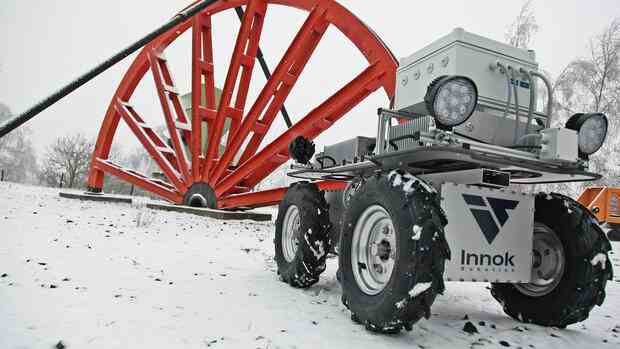The start-up now wants to scale its business model.
(Photo: Innok)
Munich Autonomous, mobile transport robots are becoming increasingly popular in factory buildings. “But that’s usually the end of the hall gates,” says Innok founder Alwin Heerklotz to the Handelsblatt. The company from near Regensburg has specialized in outdoor robots that can drive both indoors and on uneven ground, but also outdoors.
The particularly robust devices are used, for example, for watering cemeteries, for inspection tasks in mining and for transport on company premises. “There is immense potential for automation in the outdoor area,” Heerklotz is convinced.
After the first pilot projects and the delivery of vehicles, for example for the research and teaching mine of the TU Freiberg, Innok will achieve seven-digit sales for the first time this year and now wants to scale the business. “In 2030 we want to achieve sales of 100 million euros,” says CFO Peter Mauritz.
Mercedes uses whole swarms of mobile robots
In a new round of financing, Innok has now been able to attract Heinz Ferchau, founder of the large German engineering service provider Ferchau, as an investor. “I was particularly impressed by the outdoor capabilities of Innok Robotics’ AMRs, which I have never seen anywhere else,” said the entrepreneur. The start-up raised a total of five million euros.
Top jobs of the day
Find the best jobs now and
be notified by email.
Autonomous mobile robots (AMR) were initially slow to establish themselves in industry. The prices were high, and integration into the logistics and production processes was difficult. That’s about to change. Hundreds of them are on the move in the new, digitally networked Mercedes-Benz flagship factory “Factory 56”, assembling the engines and seats for the S-Class, for example.
>> Read also: Shortage of skilled workers and energy crisis: medium-sized companies are showing increasing interest in robotic solutions
The market for autonomous mobile transport vehicles is currently around three billion dollars. According to a study by Mordor Intelligence, it could grow to $14 billion by 2026.
The World Robotics Association IFR is also forecasting high growth rates: “Mobile robotics is a very dynamic field of development – we expect exciting progress here in the next ten years,” says the association. Mobile robots are becoming lighter and more flexible. Advances in sensors and software meant that transport machines could move more and more safely in outdoor environments.
According to experts, the market should grow significantly.
(Photo: Innok)
The autonomous transport robots are used in particular in intralogistics – for example for the transport of parts in the factory or on the factory premises. There are also cleaning and inspection tasks, for example.
With the growing relevance, there is a first consolidation. Manufacturers of classic robots and automation specialists are increasingly penetrating the segment. For example, ABB took over the supplier Asti Mobile Robotics. The mechanical engineering company Jungheinrich integrated Arculus. The Munich start-up develops mobile robots, but also the necessary software to control them and integrate them into the logistics and manufacturing processes.
The shortage of skilled workers increases demand
In the outdoor sector, Innok sees a large gap in the market. The machines must be more robust, have sufficient battery capacity and master the interaction of sensors and GPS information, for example. “This field is as good as vacant,” says CFO Mauritz. “But the market is huge.” The shortage of skilled workers will further increase demand.
Innok robots are used, for example, in K+S mines in difficult environments. “Nobody wants to sit on the vehicle,” says founder Heerklotz.
“There is immense potential for automation in the outdoor area.”
(Photo: Innok)
Mobile robots could now easily perform these tasks independently. This applies, for example, to the Kärcher machine that cleans the floor outside, or mobile irrigation systems for cemeteries. Corporations such as Infineon, Mercedes and Nokia have already been won as customers.
A mobile van costs 80,000 to 100,000 euros. “For many customers, that pays for itself in a year,” says CFO Mauritz. After all, they would have to buy a vehicle that would otherwise also need a driver.
There is competition from different sides. On the one hand, there are agricultural specialists like Baywa, who develop hack robots for agriculture, for example. Similar to Innok, the machines are very robust, but serve a narrower segment.
Start-ups such as Energy Robotics in particular rely on solutions for two-legged and four-legged robots that are to take on inspection tasks in car factories and on oil platforms, for example. The industry association IFR estimates that more than 37,000 inspection and maintenance robots will be sold worldwide in the coming year.
More: House building in the factory – this is how companies like Kuka want to automate the construction industry.
